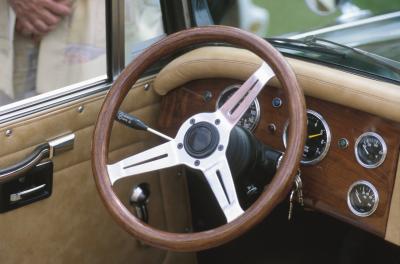
Each character in a vehicle identification number (VIN) stands for something; together the characters tell the vehicle’s story, including where it was made, by whom, the type of engine, etc. To find out the history of a pre-owned car before buying it (like repairs done, accidents experienced and ownership), all you need is the VIN, which is associated with these transactions. Today’s VIN codes contain 17 characters, but before 1981, VIN codes may have contained fewer than that. Some people make a hobby out of deciphering these codes.
Locate the VIN number in a vehicle’s title or under the bottom driver's side of a car’s windshield. You may want to write the code down so it will be easier to see.
Look at the first character: this tells you where the vehicle was built. For example, if the code starts with the number 1, the vehicle was built in the U.S. Other country of origin codes are as follows: 2: Canada / 3: Mexico / 4: United States / 5: United States / 6: Australia / 9: Brazil / J: Japan / K: Korea / S: England / T: Germany / V: France, Germany / W: Germany / Y: Finland, Sweden / Z: Italy.
Look at the second character, which identifies the vehicle’s manufacturer. For example, if the second character is a V, it was manufactured by Volvo. Other manufacturer codes are as follows: A: Audi / B: BMW / 4: Buick / 6: Cadillac / 1: Chevrolet / C: Chrysler / B: Dodge / F: Ford / 7: GM Canada / G: General Motors / H: Honda / A: Jaguar / L: Lincoln / D: Mercedes Benz / M: Mercury / N: Nissan / 3: Oldsmobile / 2 or 5: Pontiac / P: Plymouth / 8: Saturn / T: Toyota.
Notice the third character, which indicates the vehicle type or division in which it was manufactured. Each manufacturer (identified in the previous step) has different codes, so either contact them or search online to decipher the meaning of this character.
Use the same resource found above to decode the next four characters of the VIN code. The fourth through eighth characters stand for the vehicle’s features like body style, model, series and engine size.
Notice the ninth character of the VIN code. It mathematically verifies the accuracy of the previous eight characters. See the Tips section below for a link to an equation that allows you to check whether or not your VIN code is accurate to this point using, as a starting point, this ninth character.
Identify the model year of the vehicle by noting the tenth character of the VIN code — J: 1988 / K: 1989 / L: 1990 / M: 1991 / N: 1992 / P: 1993 / R: 1994 / S: 1995 / T: 1996 / V: 1997 / W: 1998 / X: 1999 / Y: 2000 / 1: 2001 / 2: 2002 / 3: 2003 / 4: 2004 / 5: 2005 / 6: 2006 / 7: 2007 / 8: 2008 / 9: 2009 / A: 2010.
Look at the eleventh character, which stands for the assembly plant at which the vehicle was made.
Identify the vehicle’s serial number, which is the last six characters of the VIN code, the final four of which may identify the production sequence of the vehicle, meaning when it came off the assembly line.